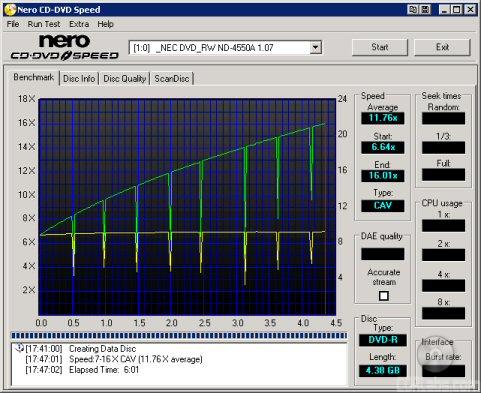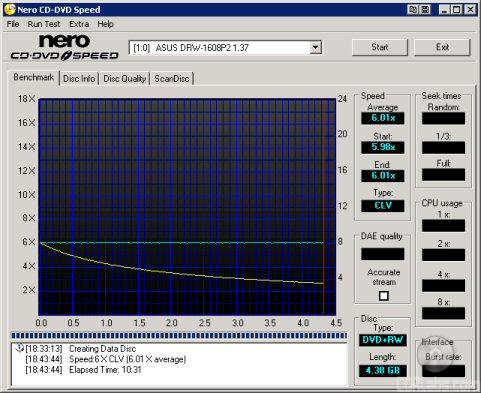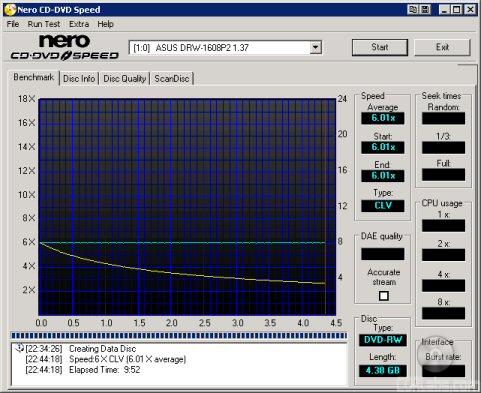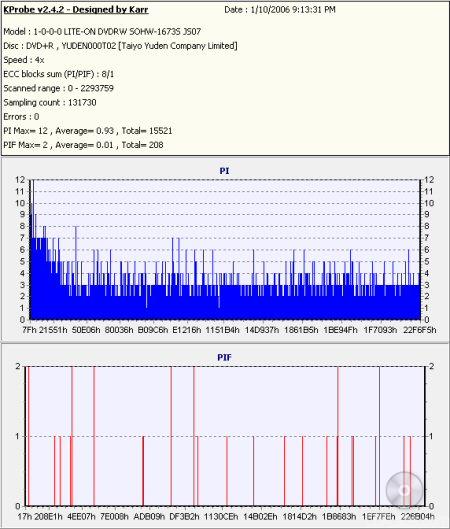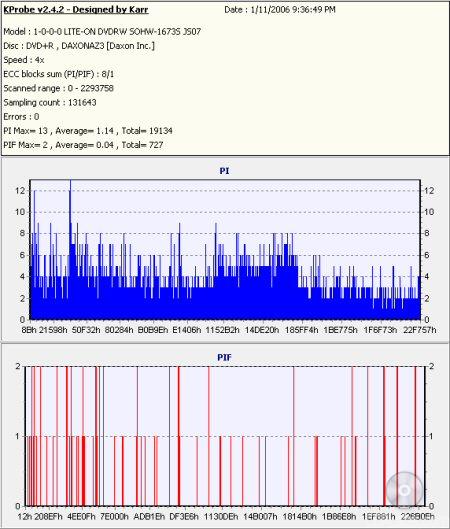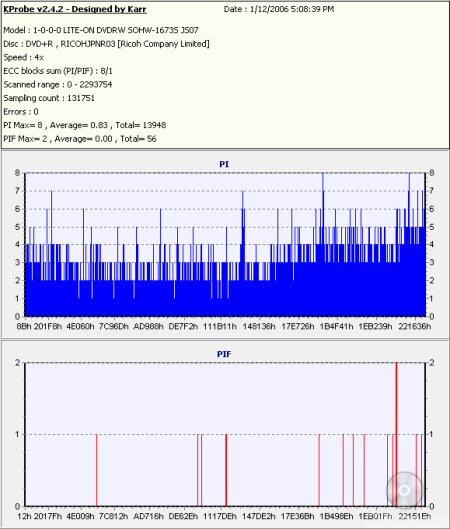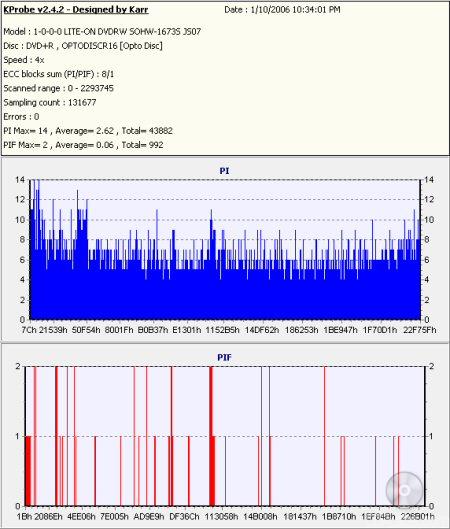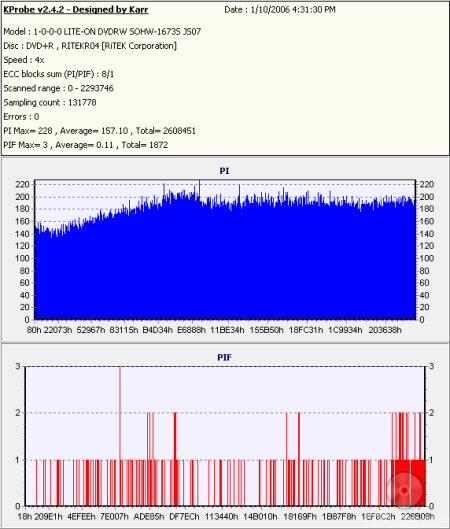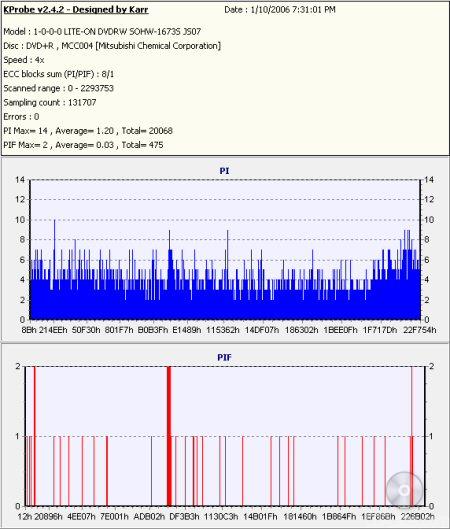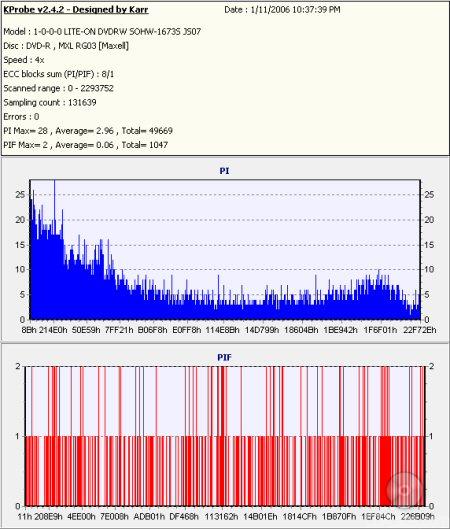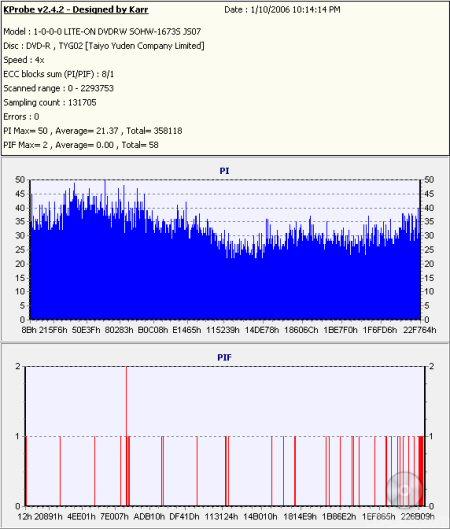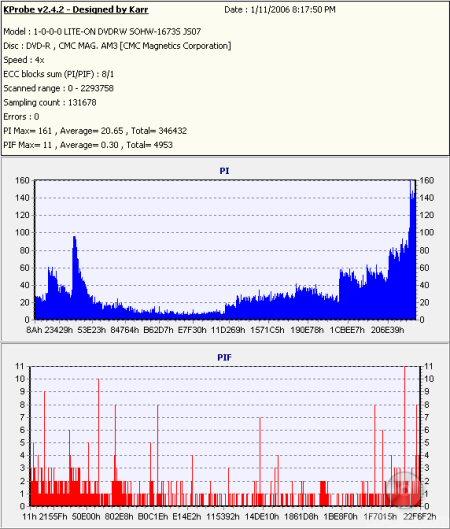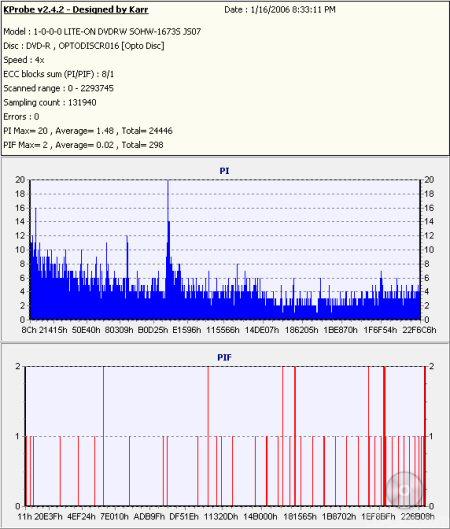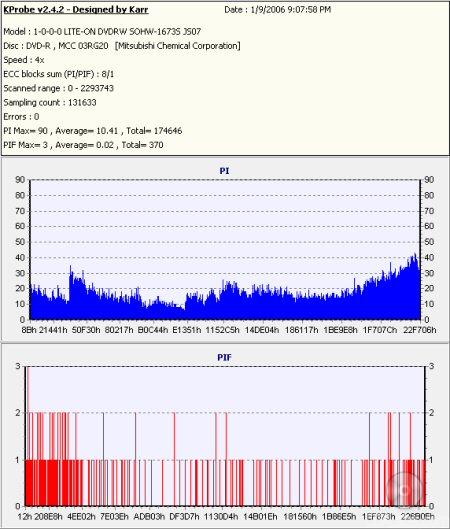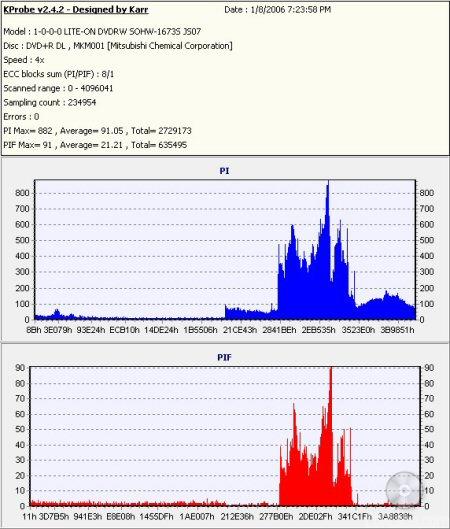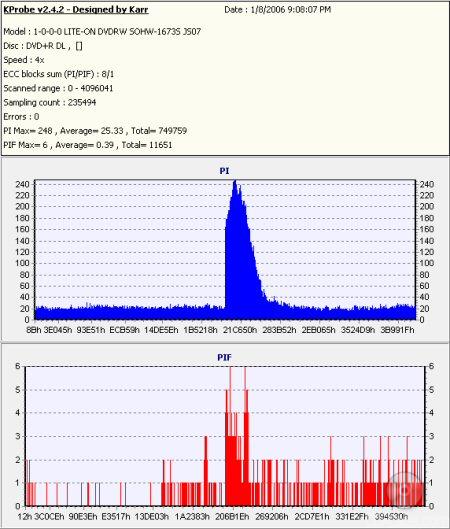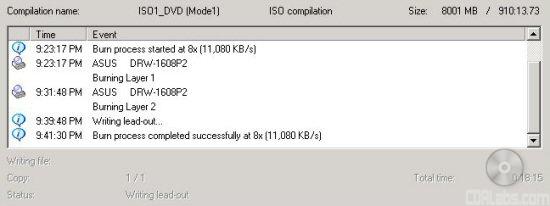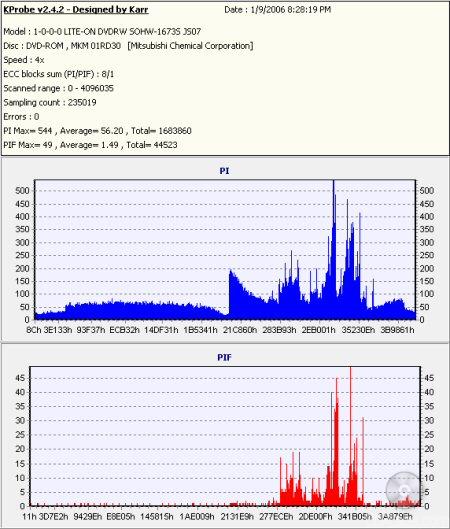DVD Write and ReWrite Tests - Nero Burning Rom 6.6.0.16 andDLA 4.95:
To test the DVD writing performance of ASUS's new drive I used Verbatim 16x DVD+R, 16x DVD-R, 8x DVD+RW and 6x DVD-RW media. To get the writing times, a 4.38GB image was burned to our test discs using Nero.
When writing to DVD+R and DVD-R media at 16x, the DRW-1608P2 uses CAV. By looking at the screenshots above, you can see that ASUS's new drive starts writing at about 6.64x and accelerates, reaching its maximum speed as it reaches the end of the disc.
According to ASUS, the DRW-1608P2 is capable of 8x DVD+RW and 6x DVD-RW writing speeds. In our tests, the drive had no problems writing to DVD-RW media at 6x. Unfortunately, we could not find any 8x DVD+RW media that would work at the drive's rated speed. We tried 8x DVD+RW media from both Verbatim and Ritek and the writing speeds were limited to 6x and 3.3x respectively.
| ASUS DRW-1608P2 |
NEC ND-4550A |
LG GSA-4167B |
Sony DRU-810A |
|
| DVD+R | 6:21 | 6:10 | 5:31 | 5:52 |
| DVD-R | 6:09 | 6:06 | 5:33 | 6:31 |
| DVD+RW | 9:30 | 7:16 | 7:20 | 7:42 |
| DVD-RW | 9:57 | 10:34 | 9:59 | 10:24 |
While not as fast as some of the other drives when writing to DVD+R discs at 16x, the DRW-1608P2 had no problems holding its own with DVD-R and DVD-RW media. Unfortunately, with its DVD+RW writing speed limited to only 6x, it was considerably slower than the drives from the competition.
To check the media compatibility of the DRW-1608P2, I ran a few tests using some of the media available in my area. The media types, along with the average time it took the drive to write our 4.38GB image, are listed below.
| Manufacturer ID | Max Write Speed |
Average Write Time |
|
| Taiyo Yuden 8x DVD+R | YUDEN000T02 | 12x | 7:40 |
| Daxon 16x DVD+R | DAXONAZ3 | 16x | 6:19 |
| Memorex 16x DVD+R | RICOHJPN R03 | 12x | 8:20 |
| Optodisc 16x DVD+R | OPTODISCR16 | 4x | 14:58 |
| RiDATA 16x DVD+R | RITEKR04 | 4x | 15:00 |
| Verbatim 16x DVD+R | MCC-004 | 16x | 6:21 |
| Maxell 8x DVD-R | MXL RG03 | 12x | 7:22 |
| Taiyo Yuden 8x DVD-R | TYG02 | 12x | 7:23 |
| Daxon 16x DVD-R | DAXON016S | 16x | 6:04 |
| Memorex 16x DVD-R | CMC MAG.AM3 | 16x | 6:07 |
| Optodisc 16x DVD-R | OPTODISCR016 | 4x | 15:06 |
| Verbatim 16x DVD-R | MCC 03RG20 | 16x | 6:09 |
The DRW-1608P2's media compatibility wasn't as good as some of the other 16x DVD writers we've tested. While it wrote to all of our 8x media at 12x, none of it worked at 16x. ASUS's new drive wouldn't write to all of our 16x media at its rated speed either. In a number of cases the writing speed was limited to only 4x.
So what about writing quality? Testing a drive's DVD writing quality isn't easy. Until now, there were very few options, unless you wanted to shell out thousands of dollars for a certified test machine. Thanks to KProbe, we can test a disc's PI (Parity Inner) and PIF (Parity Inner Fail) rates.For these tests I used a Lite-On SOHW-1673S (firmware JS07) and read the discs at 4x with the PI and PIF ECC sums set to 8 and 1 respectively. For comparison, I also tested the discs on a BenQ DW1640. When combined with Nero CD Speed, the DW1640 is able to report PI Errors, PI Failures, Parity Outer Failures and even jitter levels. For this test, the discs are read at 8x with both the PI and PIF ECC sums set to 8.
So what are "good" results supposed to look like? With KProbe, the PI errors should not exceed 280 and the number of PIF errors should stay below 4. When testing with CD Speed, the number of PI errors should stay below 280 as well. However, because it scans with an ECC sum of 8, a higher number of PIF errors is acceptable, as long as they do not exceed 32. Since POF errors are uncorrectable, we really don't want to see any of them at all.
I also put these discs through a "stress test" by reading them back at 16x with the DW1640. By reading these discs back at this speed, we can see if there are any readability issues caused by the number of errors or high levels of jitter.
|
|
|
||||||||||||||||||||||||||||||||||||||||||||||||||||||||||||||||||||||||
|
|
|
||||||||||||||||||||||||||||||||||||||||||||||||||||||||||||||||||||||||
The DRW-1608P2's writing quality was pretty good with most of the DVD+R media we tested. Aside from a few small spikes, the PI/PIF rates stayed within acceptable limits. The only real exception was Optodisc's 16x DVD+R media. When scanned with the BenQ DW1640, the PI/PIF rates jumped up considerably near the end.
|
|
|
||||||||||||||||||||||||||||||||||||||||||||||||||||||||||||||||||||||||
|
|
|
||||||||||||||||||||||||||||||||||||||||||||||||||||||||||||||||||||||||
Lastly, here are some results from our DVD-R test media. While the writing quality varied from one manufacturer to another, the results were pretty good for the most part. The only exception was Daxon's 16x media. When tested with CD Speed, there were a number of POF errors on these discs.
| ASUS DRW-1608P2 |
NEC ND-4550A |
LG GSA-4167B |
Sony DRU-810A |
|
| DVD+RW Quick | 8 seconds | 10 seconds | 9 seconds | 13 seconds |
| DVD+RW Full | 9:33 | 7:19 | 7:23 | 7:43 |
| DVD-RW Quick | 33 seconds | 36 seconds | 34 seconds | 34 seconds |
| DVD-RW Full | 10:04 | 14:20 | 10:05 | 10:23 |
To test the DRW-1608P2's packet writing performance I used DLA 4.95. Verbatim 8x DVD+RW and 6x DVD-RW media were used once again.
| ASUS DRW-1608P2 |
NEC ND-4550A |
LG GSA-4167B |
Sony DRU-810A |
|
| DVD+RW Write | 8:25 | 6:29 | 6:31 | 6:48 |
| DVD+RW Read | 8:31 | 14:39 | 9:05 | 6:07 |
| DVD-RW Write | 8:24 | 12:13 | 8:26 | 8:46 |
| DVD-RW Read | 8:30 | 6:10 | 8:40 | 6:11 |
The DRW-1608P2's packet writing performance was pretty mixed. The drive turned in some very good times when writing to DVD-RW media. However, with its DVD+RW writing speed limited to only 6x, it was again slower than the other drives in our tests.
Double Layer DVD Write Tests - Nero Burning Rom 6.6.0.16:
To test the double layer DVD writing performance of the DRW-1608P2, I used Verbatim 2.4x DVD+R DL, Memorex 2.4x DVD+R DL and Verbatim 4x DVD-R DL media. I created about 8GB of random files and directories on my hard drive and then burned them to our test discs with Nero.
The DRW-1608P2 had no problems writing to Verbatim's 2.4x DVD+R DL media at 8x. Unfortunately, Memorex's Ritek manufactured discs would not work at anything faster than 2.4x. I should also mention that we tried Verbatim's 8x DVD+R DL media, but the DRW-1608P2 wrote to it at only 2.4x. Needless to say, we didn't bother including these discs in our tests.
| ASUS DRW-1608P2 |
NEC ND-4550A |
LG GSA-4167B |
Sony DRU-810A |
|
| DVD+R DL Write | 18:46 | 18:36 | 18:47 | 15:13 |
While no match for the drive from Sony, the DRW-1608P2 took 18:57 to write 8001MB of data. So what about writing quality? Take a look below.
|
|
||||||||||||||||||||||||||||||||||||||||||||||||
The writing quality wasn't as good as I had expected with Verbatim's 2.4x DVD+R DL media. The PI/PIF rates were much higher than we'd like to see, especially when tested with the BenQ DW1640. Looking at the transfer rate graphs you can see that this had a big effect on readability. In fact, neither drive was able to read the disc back all of the way.
Memorex's DVD+R DL media didn't fair any better. While written at a slower speed, there was a large PI/PIF spike at the layer change. As you can see, this too caused some readability problems.
The DRW-1608P2 is also one of the first drives to feature 8x DVD-R DL writing speeds. To test the drive's writing times, DVD-R DL media from Verbatim was used.
ASUS's new drive had no problems writing to Verbatim's 4x DVD-R DL media at 8x. Unfortunately, RiDATA's new discs would not work at anything faster than 2x.
| ASUS DRW-1608P2 |
NEC ND-4550A |
LG GSA-4167B |
Sony DRU-810A |
|
| DVD-R DL Write | 18:15 | 20:42 | 27:00 | 29:23 |
The DRW-1608P2 had no problems taking the top spot in this test. Thanks to its 8x DVD+R DL writing speed, it took the drive only 18:15 to write 8001MB of data. So what about writing quality? Take a look below.
|
|
||||||||||||||||||||||||||||||||||||||||||||||||
Here too, the DRW-1608P2's writing quality could have been better. When writing to Verbatim's 4x DVD-R DL media at 8x, the PI/PIF rates were very high on the second layer, causing readability problems with both drives. The writing quality wasn't any better with RiDATA's new 4x DVD-R DL media. While written at only 2x, the PI/PIF rates were very high at the layer change and near the end of the session.
Performance Revisited:
When it comes down to it, the performance of ASUS's new DVD±RW drive was hit and miss. While the DRW-1608P2 held its own relatively well when writing to DVD±R, DVD-RW and DVD±R DL media, it wasn't as fast as some of the other drives when writing to DVD+RW discs. On top of that, writing quality was a big issue with DVD±R DL media. Nevertheless, the DRW-1608P2 was fairly quick when reading DVD's. In our tests, it was able to read single layer DVD's at 16x and DVD±R media at a respectable 12x.
The DRW-1608P2 also did relatively well in our CD read tests. While its seek times were higher than I would have liked, the drive had no problems reading all types of media at its rated speeds. For whatever reason though, it had a tendency to slow when ripping pressed audio CD's. When writing CD's, the DRW-1608P2 performed as expected. The drive's 40x CD-R writing speed put it at a slight disadvantage. However, its writing quality was very good. With all things considered, the ASUS DRW-1608P2 gets a 5 out of 10 for the performance section of this review.



